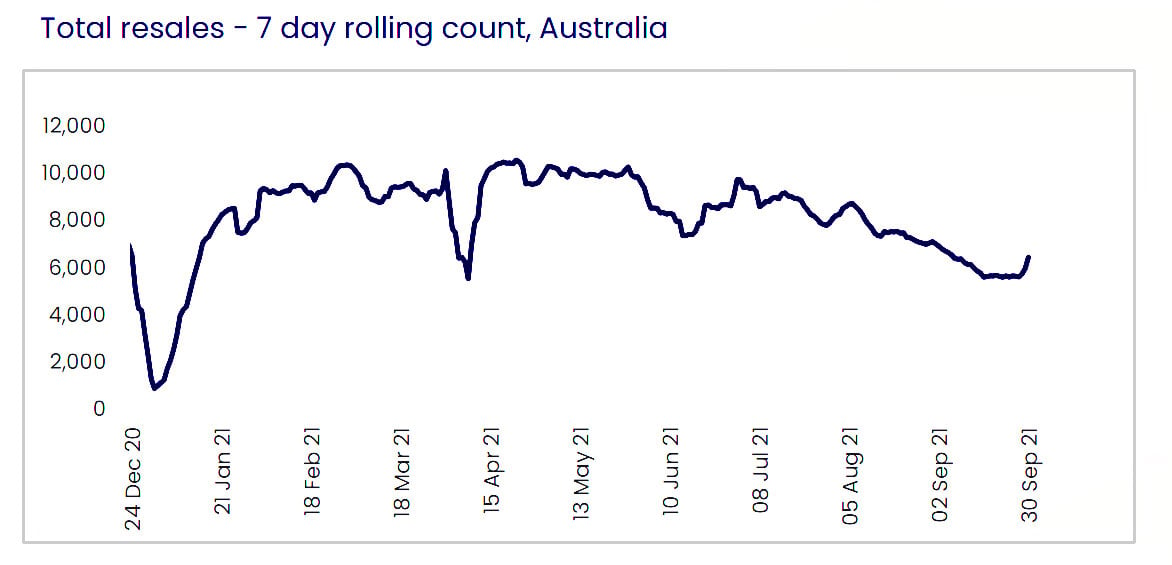Australia’s real estate resilience continued its reign through the September 2021 quarter, according to the latest CoreLogic Pain & Gain Report.
The rate of profit-making resales across Australia rose to 92.4% in the September 2021 quarter, up 0.5% from the June quarter.
The three months to September saw the highest level of profitability on resales in more than a decade.
It was another remarkable result given this quarter was marked by lockdowns across Sydney, Melbourne, and the ACT.
The increase in the rate of profit-making sales is a reflection of strong capital growth across Australian dwelling markets despite COVID-induced disruptions to transaction activity.
The three months to September was the fifth consecutive quarter in which the rate of profit-making sales across Australia increased.
The report analysed around 99,000 dwelling resale transactions during the period, down from 106,000 resale events in the June quarter, which is the result of social distancing restrictions, particularly the inability to physically inspect property across Melbourne, weighing on transaction activity.
The national median nominal gain was $270,000 with total resale profits at $27.3 billion, while median losses were -$37,000, or a total of -$368 million.
Both the combined value of profit and loss fell through the quarter, but the decline in total losses was more rapid.
Profits by hold periods
Resales had a typical hold period of 8.8 years, which was consistent on the previous quarter.
However as the market finds a peak over the next couple of years, this may incentivise more resales and we may see the average hold period shift higher, as more owners look to cash in their long-term gains.
Properties held for more than 30 years had the highest median gain of just over $745,000.
However, the highest nominal gains per year were achieved by those on the other end of the spectrum, who have held the property for two years or less.
The median gain on resales of property held for less than two years was $120,000.
Pain and Gain across Australia’s regions

Both broad regions saw an increase in profitability over the quarter, but regional Australia has seen a more rapid increase in the rate of profit-making sales, and this trend is likely to continue as regional dwelling growth saw momentum ramp up toward the end of the year.
Reflecting where we’ve seen values surge the most over the Covid period to date, sea change and tree change properties proved among the most profitable over the quarter.
Of all the SA4 markets analysed across Australia (of which there are close to 90), the highest portion of profit-making sales was in Bendigo, at 99.8%.
This was followed by Hume (99.5%), the Sunshine Coast, and Ballarat (99.3%).
Seachange and tree change markets have seen immense price growth over 2021, as the prevalence of remote work amid the pandemic, the relative affordability of regions and the potential for retirement decisions being brought amid labour market disruptions contributed to elevated levels of migration to regional Australia through 2021.
Resource-based markets generally had higher levels of loss-making sales, but are showing the most rapid signs of improvement.
Across the six major resource markets analysed, the total incidence of loss-making sales fell from 32.5% in the June 2021 quarter to 29.2% in the three months to September.
In addition to low interest rates expanding the available credit for housing, increased economic output has led to a sharp increase in commodity prices and mining investment activity, which has supported employment and housing demand.
Factors related to the pandemic exacerbated demand for housing in resource-based markets over the course of the year.
These factors included restrictions on interstate travel, which in some instances converted ‘FIFO’ working arrangements to resident workforces, and the increased desirability of regional markets through the pandemic, which may have attracted residents who are not in the resources sector.
Houses vs Units
House resales continued to have a higher chance of nominal gain (95.0%) than units (86.5%).
However, the gap between house and unit profitability is narrowing.
As affordability constraints limit growth in the detached house market and gradually deflect demand towards higher density housing options.
Profitability Outlook
With dwelling values showing further increases nationally through the December 2021 quarter, the portion of profit-making sales is expected to continue rising in the coming quarters.
However, there are accumulating headwinds for property market performance in the coming months, in the form of a higher supply of advertised stock, normalising interest rates, affordability constraints, and the possibility of tighter lending restrictions.
A downswing in Australian housing market values would ultimately impact the profitability of resales, particularly for recent purchasers.
Key findings for Pain & Gain, Sept Quarter 2021
- Around 99,000 dwelling resales were analysed for the Sept quarter Pain & Gain report
- Of those, 92.4% recorded a nominal profit-making gain from the previous purchase price, up from 87.5% in the Sept 2020 quarter
The median nominal gain made on resales nationally was $270,000, while median losses were at -$37,000
- The median hold period of those resales was unchanged from the prior quarter at 8.8 years
- Properties held for more than 30 years had the highest total median return of just over $745,000
- Properties held for two years or less had the highest nominal gain per year of $120,000
- House resales continued to have a higher chance of nominal gain (95.0%) than units (86.5%), though the gap is narrowing
- Regional Australia had a higher rate of profit than Australia’s combined capitals at 93.1% versus 91.1% respectively
- Owner-occupiers sustained a higher rate of profit-making sales nationally (95.5%) than investors (89.7%), but conditions varied across the capital cities
- Investors in Hobart were big winners, where 100% of investment home resales made a nominal gain.
ALSO READ: 2022 — A list of lists regarding the macro investment outlook










 The median nominal gain made on resales nationally was $270,000, while median losses were at -$37,000
The median nominal gain made on resales nationally was $270,000, while median losses were at -$37,000







